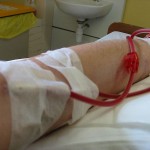Dialysis Patients Need More Treatment To Survive
Dialysis patients have always been prescribed a treatment of three times per week to remove the deadly toxins from their blood. Now, new research shows that this frequency may not be enough for their survival.
The New England Journal of Medicine published a report last week that shows dialysis patients are more likely to experience heart attacks, strokes and deaths in a two-day gap between dialysis sessions over the weekend. The risk of death or hospitalization is higher by 22 percent after a two-day break from dialysis.
Doctors and the dialysis industry have the thrice-a-week system in place since the 1960s and was set up partly to give weary patients a respite from the exhausting dialysis treatments needed to keep them alive.
Funded by the National Institutes of Health and led by Dr. Robert Foley (University of Minnesota), the study reviewed medical data from 32,000 dialysis patients in a three-year period. Data shows that almost half of patients died within two years of follow-up, many of whom died from cardiac events.
While doctors may wish to add an extra session to increase survival of ESRD patients, dialysis patients themselves are not readily willing to undergo extra treatment. A major reason is cost. Medicare covers dialysis treatment but only up to three times a week. Extra sessions are paid out of pocket or by insurance, another added burden.
Dialysis centers said they would need more staff to handle more patients. The operators are incentivized by Medicare to teach patients how to dialyze at home using their own machines. But few dialysis patients are able or willing to administer the treatment independently.
